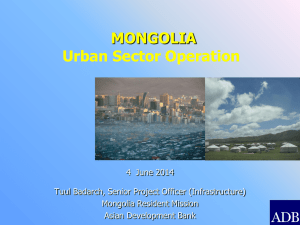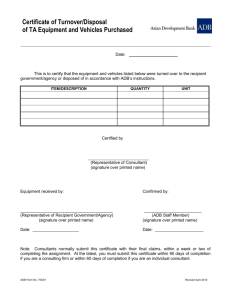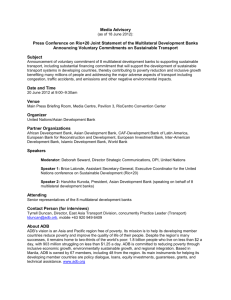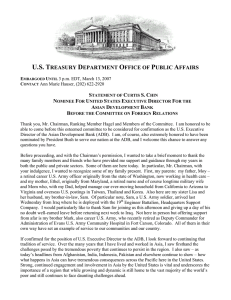5/4/15 , , and
advertisement
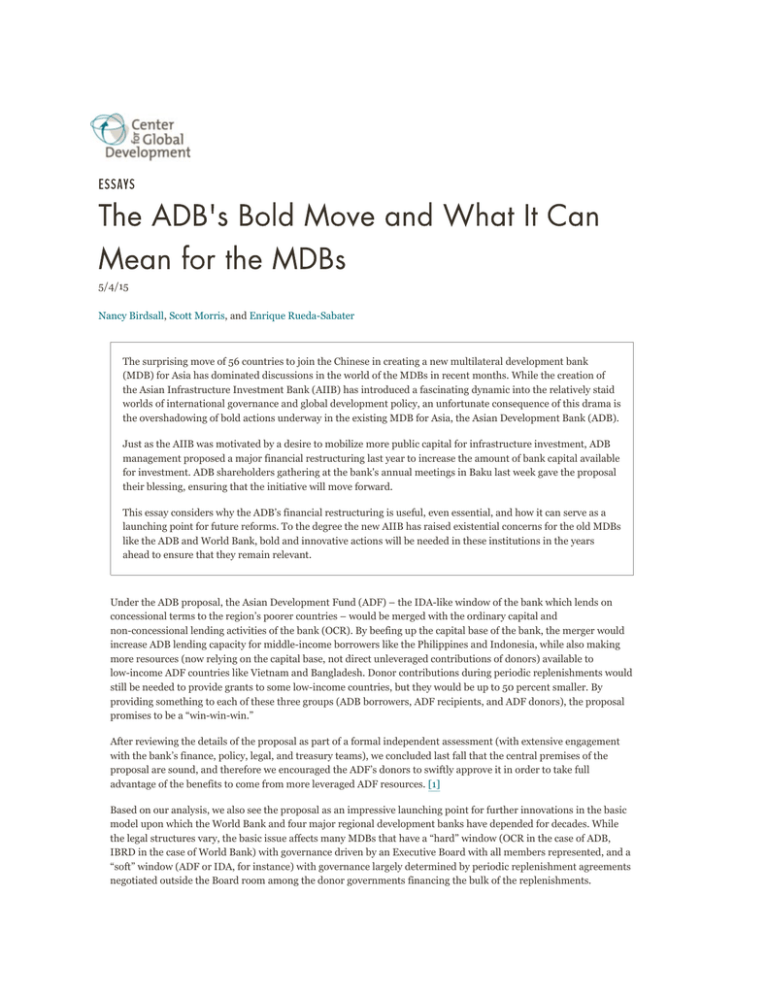
5/4/15 Nancy Birdsall, Scott Morris, and Enrique Rueda-Sabater The surprising move of 56 countries to join the Chinese in creating a new multilateral development bank (MDB) for Asia has dominated discussions in the world of the MDBs in recent months. While the creation of the Asian Infrastructure Investment Bank (AIIB) has introduced a fascinating dynamic into the relatively staid worlds of international governance and global development policy, an unfortunate consequence of this drama is the overshadowing of bold actions underway in the existing MDB for Asia, the Asian Development Bank (ADB). Just as the AIIB was motivated by a desire to mobilize more public capital for infrastructure investment, ADB management proposed a major financial restructuring last year to increase the amount of bank capital available for investment. ADB shareholders gathering at the bank's annual meetings in Baku last week gave the proposal their blessing, ensuring that the initiative will move forward. This essay considers why the ADB’s financial restructuring is useful, even essential, and how it can serve as a launching point for future reforms. To the degree the new AIIB has raised existential concerns for the old MDBs like the ADB and World Bank, bold and innovative actions will be needed in these institutions in the years ahead to ensure that they remain relevant. Under the ADB proposal, the Asian Development Fund (ADF) – the IDA-like window of the bank which lends on concessional terms to the region’s poorer countries – would be merged with the ordinary capital and non-concessional lending activities of the bank (OCR). By beefing up the capital base of the bank, the merger would increase ADB lending capacity for middle-income borrowers like the Philippines and Indonesia, while also making more resources (now relying on the capital base, not direct unleveraged contributions of donors) available to low-income ADF countries like Vietnam and Bangladesh. Donor contributions during periodic replenishments would still be needed to provide grants to some low-income countries, but they would be up to 50 percent smaller. By providing something to each of these three groups (ADB borrowers, ADF recipients, and ADF donors), the proposal promises to be a “win-win-win.” After reviewing the details of the proposal as part of a formal independent assessment (with extensive engagement with the bank’s finance, policy, legal, and treasury teams), we concluded last fall that the central premises of the proposal are sound, and therefore we encouraged the ADF’s donors to swiftly approve it in order to take full advantage of the benefits to come from more leveraged ADF resources. [1] Based on our analysis, we also see the proposal as an impressive launching point for further innovations in the basic model upon which the World Bank and four major regional development banks have depended for decades. While the legal structures vary, the basic issue affects many MDBs that have a “hard” window (OCR in the case of ADB, IBRD in the case of World Bank) with governance driven by an Executive Board with all members represented, and a “soft” window (ADF or IDA, for instance) with governance largely determined by periodic replenishment agreements negotiated outside the Board room among the donor governments financing the bulk of the replenishments. The ADB proposal is a healthy step toward greater flexibility — in particular giving the bank the opportunity to (1) revisit the balance between country-based activities and regional and global pursuits, (2) to redefine lending terms and eligibilities, and (3) to better engage the bank’s borrowers, whose economic success is not yet fully reflected in the bank’s management and governance, in mobilizing and managing the bank’s resources. We see three opportunities in particular that the ADB could usefully exploit on the heels of the financial restructuring. On the basis of the merger ADB shareholders should consider an integrated governance model that is more closely aligned with the proposal’s integrated financial structure and eliminates the quietly accepted anomaly of the shadow governance exercised by donors through the "replenishment" processes. A “bank-wide resource review” (or BRR, first explained by Scott in the case of the World Bank [2] ) could replace the ADF replenishment model with a broader ADB-wide resource review covering both the soft and hard windows. Under the current “replenishment model,” first adopted by the World Bank to fund IDA, traditional donor countries set policy for ADF and similar soft windows, while policymaking for the rest of the bank is determined by the broader constituencies of the institution (borrowers and non-borrowers alike). This bifurcated governance has created tension within the ADB as well as the other MDBs, between borrowers and non-borrowers in that it created a kind of "back door" for policy changes. [3] Although formally such mandates are eventually agreed by the Executive Board as a whole, operational policy changes introduced as part of a “replenishment” deal which has been negotiated outside the Board's can be seen as a runaround of the governance structure by the non-borrower contributors to the soft windows. Adopting a more integrated model for MDBs’ “high level” governance would help improve the transparency of policy decisions and provide a better basis for managing strategically all the available resources. In the case of ADB it would also serve to preempt the tensions that can easily arise around the use of pooled resources following the merger and provide a sounder basis for addressing trade-offs. A bank-wide resource framework could also prove more successful in broadening the donor base. Emerging market countries have been reluctant donors to all MDB soft windows. [4] They might be more inclined to participate in a grand bargain that includes a mix of grant contributions to the “soft” windows (ADF, IDA, etc.) and core capital contributions (OCR in the case of ADB, IBRD in the World Bank's case, etc.), making their total contributions more transparent. A more integrated model for MDBs’ high level governance would help improve the transparency of policy decisions. More fundamentally, a bank-wide framework could better accommodate innovative approaches to policy, whether in the form of a more nuanced framework for concessionality, or new mandates for the use of grant resources (for example, with more earmarked for cross-border infrastructure, carbon trading arrangements, regional or global public goods). We elaborate on some of these ideas further below. The ADF/ADB merger creates a ready opportunity to move from an increasingly problematic “binary” concessional/non-concessional model used by all MDBs but which is proving increasingly rigid in the face of more nuanced development finance needs — including considerations of inequality. Developing a more varied set of guidelines for concessionality would improve all countries’ (including MICs’) ability to meet anti-poverty goals while maintaining the confidence of shareholders and donors in directing resources where they are most needed. Eligibility for soft window borrowing is currently determined largely with reference to a GNI per capita threshold. Alternatively, instead of a binary notion of eligibility, concessionality levels (blended lending terms) could be along a continuum with a formula that goes beyond average indicators such as GNI per capita. [5] Consider the case for a “median” standard, which essentially combines income levels and distribution. At the same GNIpc level, median income/consumption levels vary quite a lot, and a significant number of countries that surpass the GNIpc threshold look much worse from the perspective of the median. The relevance, of course, is that the lower the median/GNI ratio, the more unequal the income distribution. Besides increased flexibility in determining the level of concessionality blend by country, the merger of soft and hard windows also opens the way for inclusion of other measures such as sub-national poverty rates or intervention measures such as project size and type. A more gradated approach to concessionality could also help to avoid the “cliff effect” in moving from concessional to non-concessional eligibility. The ADB’s proposed new financial model implies a major, front-loaded decline in donor contributions. A similar path is envisaged – given current eligibility rules – for IDA donor contributions. This decline results from a combination of net income contributions from OCR (and similarly for other hard MDB windows), repayments of old concessional loans and reduced demand as countries cross the concessional eligibility threshold. Contributions to ADF and other soft windows from ADB OCR net income (similarly with transfers from IBRD and IFC to IDA) have also been part of the replenishment deals and not resulted from strategic resource management considerations. Big non-concessional borrowers perceived these transfers as forced, non-transparent “contributions” by them — since the alternatives would be for the net income goal to be reduced and borrowing costs lowered, or for resources to be allocated to activities that also benefit non-concessional borrowers. Beside the net income issue raised above, the rapid decline carries some risk by creating essentially an early “point of no return” at the time of the next replenishment agreements when it comes to donor funding and represents a missed opportunity to consider a redirection of donor contributions. From a risk perspective, pressure on ADB or IBRD, etc. net income transfers to replace donor contributions could seriously constrain the banks' ability to respond to unexpected adverse circumstances in member countries, and by indirectly raising borrowing rates, it amounts to a non-transparent “contribution” from the MDB’s borrowers. Reducing the reliance on net income transfers and planning a more gradual phasing out of donor contributions to the soft (and grant) windows offers many advantages in general and even more so in the specific case of the ADB merger proposal. Such a transition would generate a cushion that would strengthen the sustainability of the post-merger model and would better allow for testing of some of the premises on which the proposal is built — including scalability and profitability of non-sovereign operations. Slowing down the reduction in donor contributions while maintaining current levels of net income generation offers a more balanced burden-sharing approach between hard window borrowers and donors and creates a context in which MDBs gain financial flexibility. This financial flexibility would serve them well in cases of extended crises and, in normal times, opens the door to other compelling uses for MDB resources. New demands for grant resources, either targeted at ADF countries alone or more broadly, also make a large Financial flexibility opens the door to diminution in donor grant contributions sub-optimal. For example, the grant element necessary to support a robust other compelling uses for MDB regional and global public goods agenda has long been acknowledged but not directly addressed, because of the resources. obvious trade-off against available grant funds for the ADF countries. There are certainly legal and policy challenges in shifting the underlying rationale for donor grant contributions away from the “low-income country” model. But the public goods rationale is compelling from a development policy perspective. One approach could be to initially target grants resources for regional public goods to ADF countries, for example with additional grant financing for climate mitigation and adaptation activities. Grant finance can also be compelling in the context of the ADB’s private sector agenda. The original design of the Multilateral Investment Fund at the Inter-American Development Bank provides a useful model to consider for grant-based private interventions with high development impact in priority areas like clean energy and gender. The ADB’s financial restructuring proposal offers many benefits in and of itself. But it also creates an opening for additional and complementary changes in governance that would greatly strengthen the bank and would ensure all of the benefits of the restructuring are fully captured. The merger proposal represents a highly credible down payment by the ADB on a set of innovations that can greatly expand the institution’s ability to respond to the region’s needs and opportunities — and in the process, stimulate similar dynamics at other MDBs. We very much hope that the bank and its shareholders build on this momentum in the years ahead to deliver something even bigger and better. And we also hope that progress at ADB serves as a springboard for policy changes across MDB to better integrate the management and governance of soft and hard window resources. [1] Birdsall, Nancy, Scott Morris, and Enrique Rueda-Sabater, “Review of ‘Enhancing ADB’s Financial Capacity to Achieve the Long-Term Strategic Vision for the ADF,’” Center for Global Development (2014). [2] Morris, Scott, “Shaking Up the Donor Shakedown at the World Bank,” Center for Global Development Essay (2014). [3] Kapur, Devesh, “Processes of Change in International Organizations” in Governing Globalization: Issues and Institutions ed. Deepak Nayyar (Oxford: Oxford University Press, 2002), 334. [4] These emerging countries often argue that their “contributions” occur in the form of transfers of net income from the hard to soft window that tend to increase their borrowing rates. See: Birdsall, Nancy, “The World Bank and InterAmerican Development Bank: Fit for 21st Century Purpose?” Center for Global Development Policy Paper 039 (2014). [5] Currently, there are varied levels of concessionality within MDB’s concessional silos, but these gradated terms stop sharply at the edge of these windows (delineated by a GNI per capita cutoff). Once countries graduate into hard lending, they all—from Russia to Angola—face the same market rates, regardless of relative income levels. See: Morris, Scott and Madeleine Gleave, “The World Bank at 75,” Center for Global Development Policy Paper 058 (2015).


